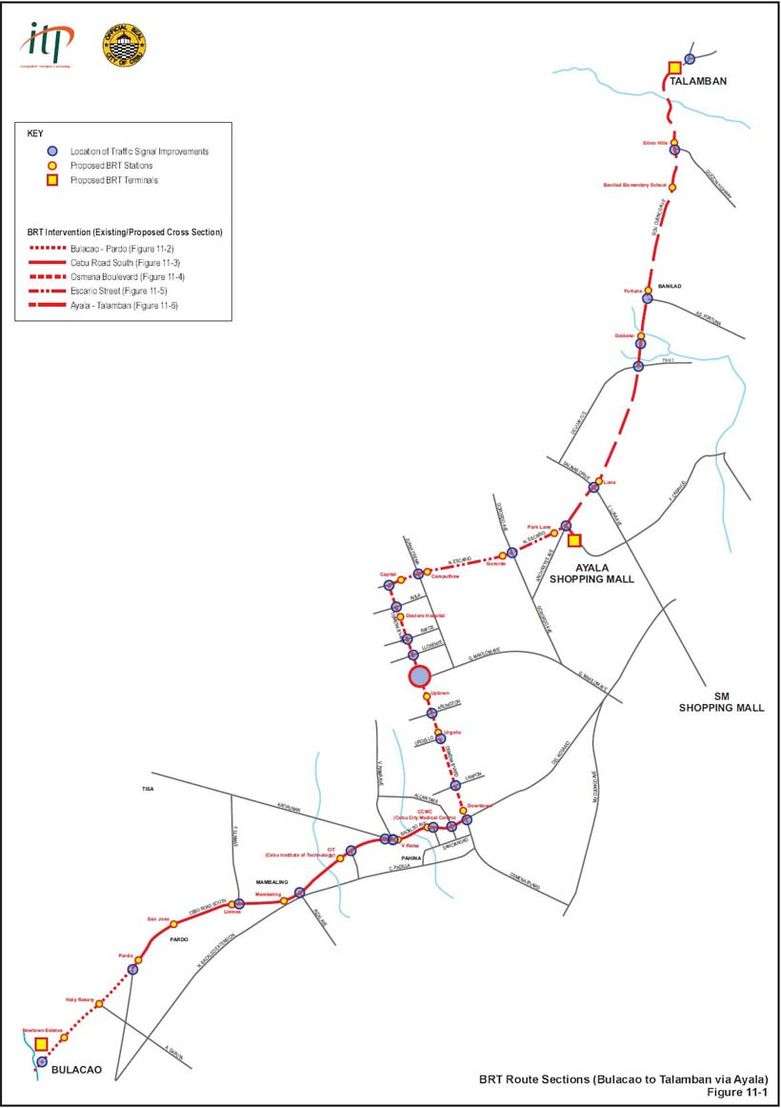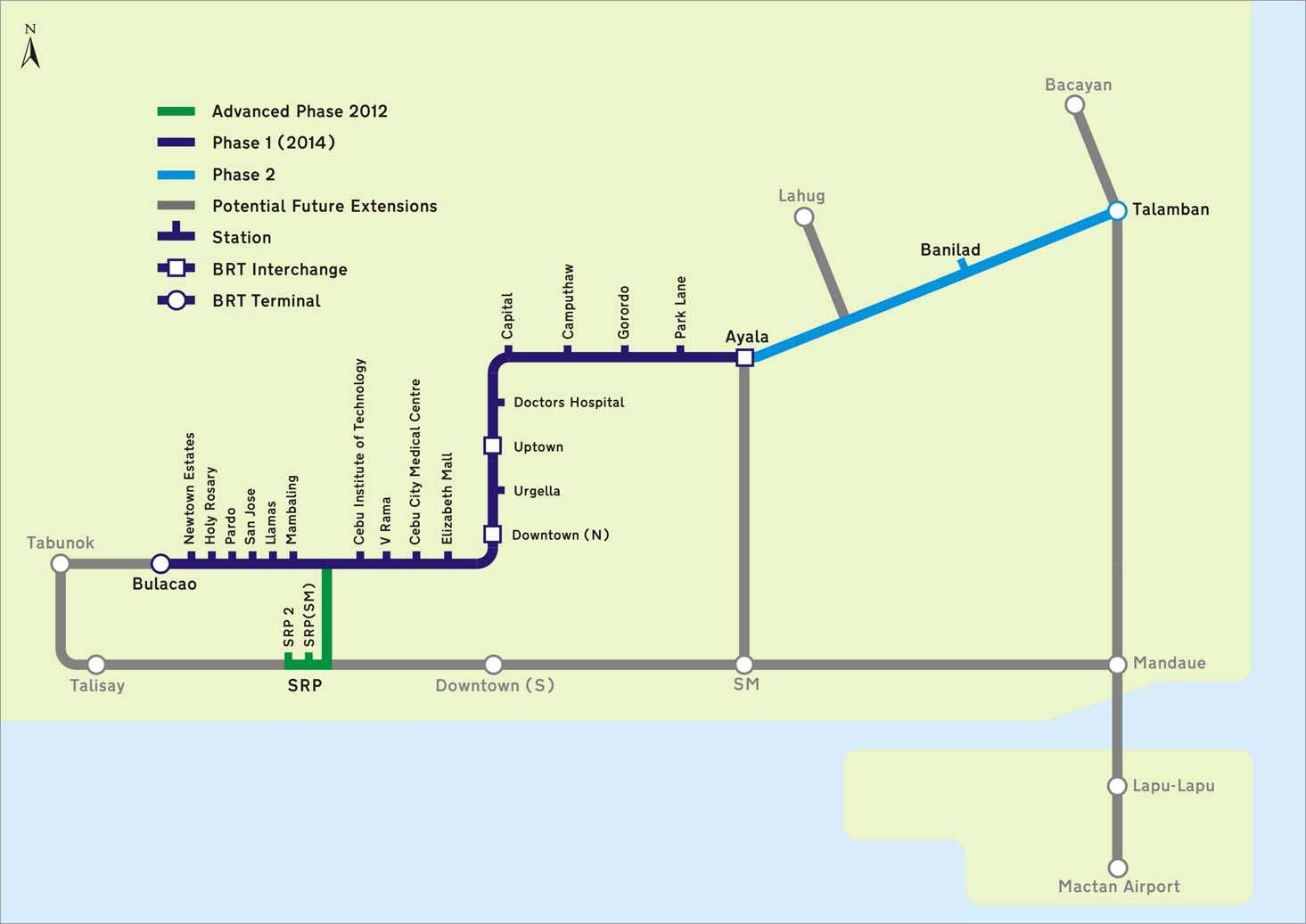Cebu Bus Rapid Transit System
| Overview | |
|---|---|
| Owner | Department of Transportation and Communication (DOTC) |
| Locale | Cebu, Philippines |
| Transit type | Bus rapid transit |
| Number of lines | 1 (1st Phase) |
| Number of stations | 33 |
| Daily ridership | 330,000 (forecast) |
| Operation | |
| Operation will start | 2018 |
| Technical | |
| System length | 16km |
| Track gauge | Segregated Busway |
| Average speed | 25.6 Km. |
The Cebu Bus Rapid Transit System is a planned mass transit system for Cebu City located within the greater Cebu Metropolitan Area. It is expected to become the first operational bus rapid transit project in the Philippines.[1] Only one line has been planned in detail so far, but scheme developers note the potential to develop a larger network comprising the adjacent cities Lapu-Lapu, Mandaue and Talisay.[2] Leadership in both Lapu-Lapu and Mandaue have shown interest in the network.[3] This will be constructed at the end or last quarter of 2016 and the first route could be operational by the end of 2018.[4]
Stage of Development
A full feasibility study has been completed by World Bank consultants Integrated Transport Planning Ltd in September 2012. This study defines the infrastructure, stations, vehicles and operational plan as well as requirements for a city wide Area Traffic Control system and improvements to the urban realm.[5] A large public consultation scheme was undertaken during this study which engaged directly with 5,000 Cebuano's as well as communication via newspapers, TV, radio and social media.
A Bus Rapid Transit system for Cebu City was first proposed by Mayor Tomas Osmeña in the 1990s, but it was 2008 when the Department of Transportation and Communication (DOTC) began formal planning.[6] The World Bank is supporting the scheme financially and technically through its Clean Technology Fund.[1] The Philippines National Government at first diapproved this project, but later it supported the project financially as President Benigno S. Aquino III has placed it among his top 16 Public-Private Partnership projects to pursue.[7] The former Mayor of Cebu City, Michael Rama, is also supportive of the plans and has formed two steering committees to advise on policies and provide technical expertise.[8] The Cebu City Team is headed by former Cebu City Councilor Nestor Archival, as the former Cebu BRT Project Development Officer, Engr. Nigel Paul Villarete, transferred to the Mactan-Cebu International Airport on October 26, 2010.[9]
After the feasibility study, areas affected by road right of way (ROW) or road widening were marked with varying measurements ranging from less than a meter to 13 meters. Those with BRT stations have larger ROWs. The ROW is also expected to displace many houses and establishments and affect many roadside trees.
The project is expected to start on the last quarter of 2016 and will finish within 2 to 3 years or in 2018 or 2019.
Route
The route comprises 11 km of segregated busways from Bulacao to Ayala Mall along Cebu South Road, N Bacalsco Ave, Osmena Boulevard and N Escario St, and a further 6 km of bus priority at junctions will allow BRT buses to reach Talamban along Gov M Cuenco Ave. This will link the following key destinations; Central Business District, Capitol Site, Ayala Shopping Mall and IT Park.[10] A spur to the 300-hectare Cebu South Reclamation Project (SRP) is also planned as developers Filinvest seek to integrate BRT provision into their development plans.[11]

| |||||||||||||||||||||||||||||||||||||||||||||||||||||||||||||||||||||||||||||||||||||||||||||||||||||||||||
The BRT vehicles will run along segregated bus lanes that run down the middle of the road. Stations will also be located in the middle of the road and will be accessed by footbridges or pedestrian crossings. 33 stations have been proposed including terminals at Ayala Shopping Mall, Talamban and Bulacao.[5]
When completed, the Cebu BRT system will have 33 stations with 176 buses with buses passing each station every two to five minutes. About 330,000 passengers are expected to use the BRT line every day.
A modified Jeepney network is expected to operate feeder and complementary services to the BRT route. Space will be made at BRT stations for interchange with Jeepney routes.[12]
BRT Terminal
The design is inspired by the sun and by flowers. It reflects the sunny disposition of Cebu, the bright and cheerful nature of our people and our festivals.Long lines are stressed and configured through the walls.BRT office chief Rafael Yap said the design is part of the initial input of the ongoing detailed engineering design for the project.Yap said the project’s first phase covering the Osmena Boulevard will be built next year since it is less burdened by road riģht of way concerns.The BRT station will be four meters wide and 83 meters long.The BRT first phase from Bulacao to Ayala will consist of 15 symmetric and asymmetric stations.[13]

Branding
TransCebu is the proposed name for the BRT line. Single deck non-articulated buses which hold between 85 and 110 passengers will be used. A running speed of 25 km/hr is proposed with a peak frequency of 75 buses per hour on the core route.[5] This operation is expected to carry 330,000 Cebuanos each day.[12]


Ticketing and Fares
Ticketing is likely to use pre-pay smart cards like that used for Rapid Transport in Singapore and Hong Kong. The pre-feasibility assessment for the BRT route states that if the fares were charged at the same level as Jeepneys then the ticket revenue would be US$15 million per year, of which US$1.5 million is expected to be profit/surplus.[12]
Costs and benefits

The route will be constructed in two phases, the first from Bulacao to Ayala Mall which should be operational late 2014 and the second from Ayala Mall to Talamban which would be pursued later.[2] The capital cost of the infrastructure is estimated to be US$115 million,[7] which equates to US$7 million per kilometre.
The pre-feasibility study estimates that in comparison to using Jeepneys the BRT route will save Cebuanos 570 million hours of travelling per year[12] and will also be cheaper for the bus operators as BRT vehicles are cheaper to run than the existing Jeepneys. The overall cost benefit ratio has been evaluated to be 2.45.[2]
If the buses were to run on diesel then the route is estimated to save 9,655 tonnes of PM10 emissions and 1.6 million tonnes of CO2 emissions up to the year 2035.[2] However the DOTC is also considering running the vehicles on LPG, biofuel, hybrid or electricity which will reduce emissions further.[14]
Potential BRT Full Network for Metropolitan Cebu
The full BRT network for Metropolitan Cebu could cover the cities of Talisay, Cebu, Mandaue, and Lapu-lapu, passing through the South Road Properties (SRP), and connecting to the Mactan-Cebu International Airport (MCIA). There could also be a BRT network at downtown Cebu specially at Colon Street.

References
- 1 2 Valentina Lopez (July 2010). “Update: The Progression of the Cebu BRT Project and its Impact in the Philippines”. PPIAF. Retrieved 2011-01-27
- 1 2 3 4 Integrated Transport Planning Ltd (2010). “Study and Concept Plan for a Demonstration Bus Rapid Transit Corridor”. For World Bank and PPIAF.
- ↑ Philippines News Agency (1 June 2010). "Mandaue, Lapu-Lapu cities want bus transit system”. Retrieved 2011-01-27
- ↑ Philippines News Agency (20 December 2010). “Cebu City’s BRT project takes 3 years to finish”. Retrieved 2011-01-27
- 1 2 3 Integrated Transport Planning Ltd (2012). “Cebu BRT Feasibility Study". For World Bank.
- ↑ Cris Evert Lato (18 September 2010). "Cebu City awaits bus rapid system”. Philippine Daily Inquirer. Retrieved 2011-09-27
- 1 2 Jessica Ann Pareja (26 October 2010). “BRT, MCIAA development among P.Noy’s top projects”. The Freeman. Retrieved 2011-09-27
- ↑ Positive News Media (30 December 2010). “Mayor Rama forms two committees for proposed BRT system”. Retrieved 2011-01-27
- ↑ Jessica Ann R. Pareja/JMO (23 October 2010). "Archival to lead BRT team as Villarete heads to MCIA". The Freeman
- ↑ Philippines News Agency (8 June 2010). "Cebu City wants national gov’t to spend for BRT implementation”. Retrieved 2011-01-27
- ↑ Philippines News Agency (27 August 2010). "Filinvest asks Ceby City government to finalize SRP utilities”. Retrieved 2011-01-27
- 1 2 3 4 Philippines News Agency (17 June 2010). “Cebu City’s proposed BRT to earn US$ 15M a year, foreign consultants say”. Retrieved 2011-01-28
- ↑ Bunachita, Jose Santino S. (2015-11-03). "City Hall unveils BRT terminal design". Retrieved 2016-07-11.
- ↑ Philippines News Agency (22 October 2010). "WB okays US$ 1M grant for Cebu City’s rapid bus transit feasibility study”. Retrieved 2011-01-28
External links
- Bus Rapid Transit Planning Guide (available for download in pdf) Institute for Transportation & Development Policy
- Bus Rapid Transit, Volume 1: Case Studies in Bus Rapid Transit Transportation Research Board
- Bus Rapid Transit, Volume 2: Implementation Guidelines Transportation Research Board
- The National BRT Institute
- BRT Technologies: Assisting Drivers Operating Buses on Road Shoulders. University of Minnesota Center for Transportation Studies, Department of Mechanical Engineering (December 2003).
- Bus Rapid Transit Policy Center
- Institute for Transportation and Development Policy
- Across Latitudes and Cultures Bus Rapid Transit An international Centre of Excellence for BRT development
- Transit Capacity and Quality of Service Manual Transportation Research Board
- The Climate Investment Funds and the Clean Technology Fund